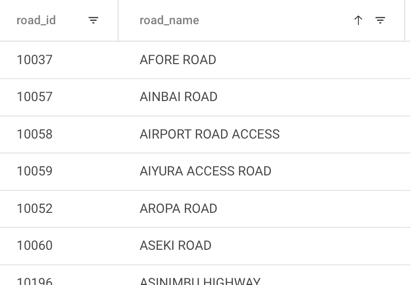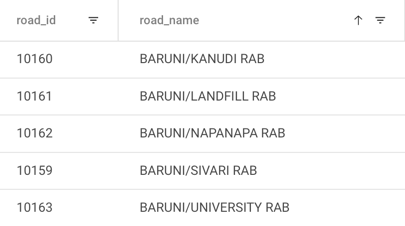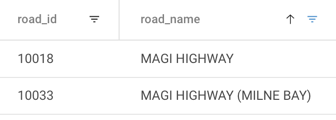A register of all Roads (including Highways) is maintained in the RAMM Road Name (roadnames) table.
 The AWM Road Name table can be accessed from the AWM Menu.
The AWM Road Name table can be accessed from the AWM Menu.
The Road Name table contains information about the road name records, including the type of network the record belongs to (see AWM Network Model for more information).
Specifically, key attributes managed in the RAMM Road Name table includes:
- The Road ID (road_id); which is a unique database road identifier for each road.
- The Road Name (road_name); which is typically the road name as vested to PNGDoWH. The AWM name may have an additional abbreviation or suffix appended to it to provide further context about the road or avoid duplication of names.
- The Road Type (road_type); which is used to classify the network the road belongs to.
The Road ID is the most critical information in the AWM database as it supports a location for every object managed in the database as well as forming the link for converting between linear and spatial information. Even if assets are to be managed spatially in RAMM, they must have a Road ID at a minimum.
What Data Should be Managed to Define a Road?
Refer to the Data Standard that sets out all of the data expected to be managed in AWM to define a road.
Road Naming Convention and Abbreviations
For consistency, the names of roads in AWM must adhere to the following naming conventions.
- All road names must be entered into the AWM Road Name (roadnames) table. This is locked to upper case characters only e.g. use "BUKA ROAD" instead of "Buka Road".
 Road names are written in upper case characters in the AWM Road Name table.
Road names are written in upper case characters in the AWM Road Name table. - All National Roads (NR) are to have a road name that ends in "Highway".
- All roads below a National Road (NR) class cannot have a road name that ends in "Highway". They will usually end in "Road".
- The standard abbreviation to use when naming a roundabout in RAMM is “RAB”. This is to be appended as a suffix to the road name. For more information on naming roundabouts in RAMM, please refer to the Roundabout Naming Convention section below.
 Roundabouts in AWM using the RAB abbreviation.
Roundabouts in AWM using the RAB abbreviation. - Road names may have additional naming elements added in RAMM to help provide further context and clarity about the road e.g. adding a suffix of NORTH or SOUTH. If this naming element is not part of the actual road name, it must be placed in brackets as a suffix to the road name, e.g., CAMERON ROAD (WESTBOUND). This rule applies to all suffixes that may need to be added to names in the Road Name (roadnames) table, but excludes the “RAB” abbreviation for roundabouts.
 The (WESTBOUND) suffix for CAMERON ROAD.
The (WESTBOUND) suffix for CAMERON ROAD. - All road names in the AWM Road Name (roadnames) table must be unique. Where a road name is to be added which would be a duplicate of an existing name, then the Province, Town or Suburb name shall be included in brackets as a suffix, to create a unique road name e.g., MAGI HIGHWAY (MILNE BAY)
 The (MILNE BAY) suffix has been applied to create a unique set of road names for the two MAGI HIGHWAY RAMM roads.
The (MILNE BAY) suffix has been applied to create a unique set of road names for the two MAGI HIGHWAY RAMM roads.
Roundabout Naming Convention
Roundabouts are named in such a way that clearly identifies and distinguishes each roundabout from the others.
In almost all cases, a roundabout has more than one road associated with it, and one of those roads will be more 'major' than the other road (e.g. a road may be more major than another road when considering factors such as carriageway section hierarchy and traffic volumes).
Please refer to Road Classifications for more information on the road classification system.
The naming convention for roundabouts is for the major road to be named first, followed by the next major road. For example, if CAMERON ROAD was the major road, and WARDS ROAD was the minor road, then the roundabout name in AWM would be CAMERON/WARDS RAB. If a roundabout has more than two roads associated with it, typically only two roads are referenced in the name.
 The Roundabout Naming Convention applied to the Cameron/Wards RAB.
The Roundabout Naming Convention applied to the Cameron/Wards RAB.
When naming a roundabout, the ROAD component is removed from each contributing road name to reduce clutter. In the example above, the word ROAD has been omitted from both CAMERON ROAD and WARDS ROAD when naming the roundabout.
Roundabouts can be numbered if, when following this naming convention, there would be more than one roundabout with the same name e.g. CAMERON/WARDS RAB (No.1), CAMERON/WARDS RAB (No.2).
Road Numbering Conventions
The road number is managed adn maintianed in the cariageway table. This is allows mamangement of the Road Number across region and provincal boundaries.
Road Numbers are a setup as a:
- Combination of prefix A, B, C,
- Followed by a sequential number.
- In some caes this is furhter suffixed with a letter where road section(s) in questions have signifcant section changes. This is gernally aligned to the known geographical oreintation of the road.
The specific rule to the Road Numbering process is that
- all NATIONAL ROUTES are prefixed by the letter 'A' in all cases.
- Road numbers must be unique across the full road network.
- A road number can only be used for one road name and vice versa.
Note: this will require carriageways to be split at provincial boundaries so that it can have a new road number.




